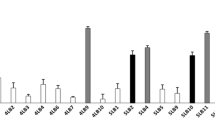Abstract
The lactobacilli probiotics maintain a normal vaginal biota and prevent disease recurrence. This microorganisms form a pellicle on the vaginal epithelium that acts as a biologic barrier against colonization by pathogenic bacteria. In this paper were realized assays of exclusion, competition, and displacement. For these test, vaginal epithelial cells, two strains of lactobacilli and pathogenic bacteria (Staphylococcus aureus, Streptococcus agalactiae and Listeria monocytogenes) were used. The lactobacilli strains showed a great capacity of adherence, with a mean of 83.5 ± 26.67 Lactobacillus fermentum cells and 56.2 ± 20.87 Lactobacillus rhamnosus cells per vaginal epithelial cells. L. fermentum and L. rhamnosus were able to reduce the adherence of S. aureus, S. agalactiae and L. monocytogenes in a significant level in this assay (P < 0.01). The lactobacilli used in this study protect the vaginal epithelium through a series of barriers and interference mechanisms. The aim of present study was to assess the ability of vaginal Lactobacillus strains, selected for their probiotic properties, to block the adherence of pathogenic microorganisms in vitro by displacement, competition, and exclusion mechanisms.

Similar content being viewed by others
References
Bergey`s Manual of Determinative Bacteriology (1994). Group 4 pp 71–174; Group 5 pp 175–289; Group 17 pp 527–558. In: Holt JG (ed), 9th edn. Williams & Wilkins, Baltimore
Bonetti A, Morelli L, Campominosi E, Ganora E, Sforza F (2003) Adherence of Lactobacillus plantarum P 17630 in soft-gel capsule formulation versus Döderlein’s bacillus in tablet formulation to vaginal epithelial cells. Minerva Ginecol. 55(3):279–284 284–7
Boris S, Barbés C (2000) Role played by lactobacilli in controlling the population of vaginal pathogens. Microbes Infect 2:543–546
Cepeda C, Santos Y (2000) Rapid and low-level toxic PCR-based method for routine identification of Flavobacterium psychrophilum. Int Microbiol 3:235–238
Cheesbrough M (2002) Medical laboratory manual for tropical countries 2. Tropical Health Technology, London, p 479
Chichlowski M, Croom J, McBride B, Havenstein G, Koci M (2007) Metabolic and physiological impact of probiotics or direct-fed-microbials on poultry: a brief review of current knowledge. Int J Poult Sci 6(10):694–704
Koneman E, Winn W, Allen S, Janda W, Procop G, Schreckenberger P, Woods G (2006). Diagnóstico Microbiológico. Texto y Atlas color. 6ta Edición. Cap. 12. Cocos Grampositivos. p 593–638. Editorial Panamericana
Kwok L, Stapleton AE, Stamm WE, Hillier SL, Wobbe CL, Gupta K (2006) Adherence of Lactobacillus crispatus to vaginal epithelial cells from women with or without a history of recurrent urinary tract infection. J Urol 176:2050–2054
Lane DJ (1991) 16S/23S rRNA sequencing. In: Stackebrant E, Goodfellow M (eds) Nucleic acid techniques in bacterial systematic. Wiley, New York, pp 115–175
Lee Y (2005) Characterization of Weisella kimchii PL9023 as a potencial probiotic for women. FEMS Microbiol Lett 250:157–162
Lee Y-K, Puong K-Y, Ouwehand AC, Salminen S (2003) Displacement of bacterial pathogens from mucus and Caco-2 cell surface by lactobacilli. J Med Microbiol 52:925–930
Lepargneur JP, Rousseau V (2002) Protective role of the Doderlein flora. J Gynecol Obstet Biol Reprod 31:485–494
Nigatu A, Ahrne S, Molin G (2000) Temperature-dependent variation in API 50 CH fermentation profiles of Lactobacillus species. Curr Microbiol 41:21–26
Ohashi Y, Ushida K (2009) Health-beneficial effects of probiotics: its mode of action. Anim Sci J 80:361–371
Osset J, Bartolomé RM, García E, Andreu A (2001) Assessment of the capacity of Lactobacillus to inhibit the growth of uropathogens and block their adhesión to vaginal epithelial cells. J Infect Dis 183:485–491
Pascual L, Daniele MB, Pájaro C, Barberis L (2006) Lactobacillus species isolated from the vagina: identification, hydrogen, peroxide production and nonoxynol-9 resistance. Contraception 73(1):78–81
Pascual L, Ruiz F, Giordano W, Barberis L (2010) Vaginal colonization and activity of the probiotic bacterium Lactobacillus fermentum L23 in a murine model of vaginal tract infection. J Med Microbiol 59:360–364. doi:10.1099/jmm.0.012583-0
Pascual LM, Daniele MB, Ruiz F, Giordano W, Pajaro C, Barberis L (2008) Lactobacillus rhamnosus L60, a potential probiotic isolated from the human vagina. J Gen Appl Microbiol 54:141–148
Pineiro M, Staton C (2007) Probiotic bacteria: legislative framework requirements to evidence basis. J Nutr 137:850S–853S
Reid G, Burton J (2002) Use of Lactobacillus to prevent infection by pathogenic bacteria. Microbes Infect 4:319–324
Ruíz F, Gerbaldo G, García M, Giordano W, Pascual L, Barberis I (2012) Synergistic Effect between two bacteriocin-like inhibitory substances produced by lactobacilli strains with inhibitory activity for Streptococcus agalactiae. Curr Microbiol. doi:10.1007/s00284-011-0077-0
Sha BE, Zariffard MR, Wang QJ, Chen HY, Bremer J, Cohen MH, Spear GT (2005) Female genital-tract HIV load correlates inversely with Lactobacillus species but positively with bacterial vaginosis and Mycoplasma hominis. J Infect Dis 191:25–32
Velraeds M, Van De Belt-Gritter B, Van Der Mei H, Reid G, Busscher H (1998) Interference in initial adhesion of uropathogenic bacteria and yeasts and silicone rubber by a Lactobacillus acidophilus biosurfactant. J Med Microbiol 47:1081–1085
Wiesenfeld HC, Hillier SL, Krohn MA, Landers DV, Sweet R (2003) Bacterial vaginosis is a strong predictor of Neisseria gonorrhoeae and Chlamydia trachomatis infection. Clin Infect Dis 36:663–668
Wilson M (2005) The reproductive system and its indigenous microbiota, Microbial inhabitants of humans: their ecology and role in healthand disease. Cambridge University Press, New York, pp 206–250
Zhou X, Brown CJ, Abdo Z, Davis CC, Hansmann MA, Joyce P, Foster JA, Forney LJ (2007) Differences in the composition of vaginal microbial communities found in healthy Caucasian and black women. ISMEJ 1:121–133
Acknowledgments
This study was supported by the Secretaría de Ciencia y Técnica de la Universidad Nacional de Río Cuarto.
Author information
Authors and Affiliations
Corresponding author
Rights and permissions
About this article
Cite this article
Ortiz, L., Ruiz, F., Pascual, L. et al. Effect of Two Probiotic Strains of Lactobacillus on In Vitro Adherence of Listeria monocytogenes, Streptococcus agalactiae, and Staphylococcus aureus to Vaginal Epithelial Cells. Curr Microbiol 68, 679–684 (2014). https://doi.org/10.1007/s00284-014-0524-9
Received:
Accepted:
Published:
Issue Date:
DOI: https://doi.org/10.1007/s00284-014-0524-9




